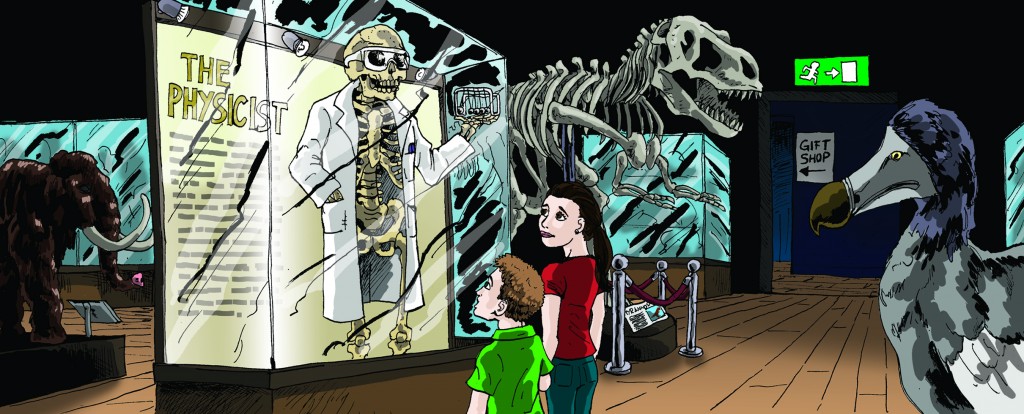THURSDAY, 1 OCTOBER 2009
Many physicists dream of completing a Theory of Everything: a fundamental concept, based on which all physical phenomena in the universe could be explained. Ironically, such a theory could threaten the existence of physicists themselves. How close are we to developing this theory and will it indeed make physicists redundant?In order to understand why physicists believe a Theory of Everything is a real possibility, it is imperative to look at the history of the subject. Put simply, the study of physics has consisted of describing the four fundamental forces – electromagnetism, gravity, the strong force and the weak interaction – and linking seemingly disparate phenomena by unifying different forces. Work by Faraday, Maxwell and Einstein demonstrated that electricity and magnetism are two different manifestations of a single electromagnetic force. Similarly, Weinberg, Glashow and Salam showed that both the electromagnetic and weak force could be unified in a single electroweak interaction. More recently, researchers have tried to demonstrate that, at high energies, there is a unification of the electroweak and strong force as part of a so-called ‘Grand Unified Theory’. Ultimately, theorists such as Leonard Susskind, one of the fathers of string theory, aim to include gravity, the one force which has proven particularly resistant to unification, in a Theory of Everything.
There are two different paths for the future of physics and both need to be considered to evaluate whether physicists might soon become an endangered species. On one hand, we could assume that ‘the Theory of Everything’ will be found based on the history of physics. One of the candidates is the aforementioned string theory. In brief, string theory argues that all particles are created as a result of the vibrations of extremely tiny strings. Although perhaps the most promising of any Theory of Everything candidate, controversy rages over whether the theory makes testable predictions. If string theory, or any of its successors, proved to be entirely successful, could one then dispense with all physicists and use their generous research funding for more worthwhile pursuits? For many reasons, the answer is an emphatic no. First, only experienced physicists will be able to apply such a fundamental theory in real-world calculations. Quantum mechanics, for instance, yields few analytic solutions. The celebrated Schrödinger Equation, describing the wave-like behaviour of one or more particles, can only be solved analytically in a few idealised situations. The most fundamental theory in physics will presumably consist of equations that are even more difficult to solve.
A Theory of Everything would also open up questions of enquiry that we cannot yet fathom and would undoubtedly shed new light on previously ‘solved’ problems. For example, when the American physicist Julian Schwinger developed a mathematically successful theory of the motion of charges (i.e. quantum electrodynamics), his colleague Richard Feynman was able to illuminate the problem from a more visual perspective by inventing the now-ubiquitous Feynman diagrams. Furthermore, although they may be reluctant to admit it, many physicists have a strong philosophical bent. For instance, despite the fact that quantum mechanics was developed during the early 20th century, interpretations of how it shapes our understanding of ‘reality’ continue to be proposed to this day. A Theory of Everything is likely to be at least as challenging to comprehend.
Another scenario is that a Theory of Everything does not exist. This is not implausible. Apart from past experience and perhaps an intuitive preference for fundamental simplicity, no significant evidence points in the direction of a Theory of Everything. One alternative, corroborated to some degree by the continual discovery of smaller and smaller particles, over the last 100 years, is that the discipline will unfold much like an onion. This would mean that modern, ultra-sensitive experiments would show discrepancies between current theories and the way the universe actually works. New theories would have to be developed to account for the deviations; alternatively, empirical verification could come after the proposal of such theories. This process would continue ad infinitum. Mao Zedong, was a strong proponent of the view that finding smaller and smaller particles would be a never-ending process.
Indeed, the idea that physics will continue to unfold indefinitely is consistent with Thomas Kuhn’s ideas about the nature of scientific progress. In his seminal contribution The Structure of Scientific Revolutions Kuhn argues that science does not progress in a linear manner but rather by paradigm shifts, effectively excluding the possibility of an ultimate Theory of Everything. Kuhn’s ideas have been borne from the history of science. At the dawn of the 20th century, for example, physics was considered to be complete: Maxwell’s equations elegantly accounted for electromagnetism, Newtonian mechanics described the general motion of all bodies and Boltzmann statistics effectively handled multi-particle systems. However, the advent of both Einstein’s Theory of Relativity and quantum mechanics made it clear that profound physical concepts had so far been neglected. If Kuhn’s thesis is correct, such paradigm shifts will never cease. Interestingly, even if future developments continue to bring physics ever closer to ‘completion’, the subject may never be fully consistent.
Ultimately, physicists have disagreed widely on whether physics could be unified in a single theory. While two giants of 20th century physics, Murray Gell-Mann and Albert Einstein, played prominent roles in the development of a Theory of Everything, another giant, Richard Feynman, argued that such theories are not falsifiable. Whatever the final truth may be, physicists are probably not out of a job.
Frederik Floether is a Natural Sciences Tripos Part II student in the Department of Physics.


